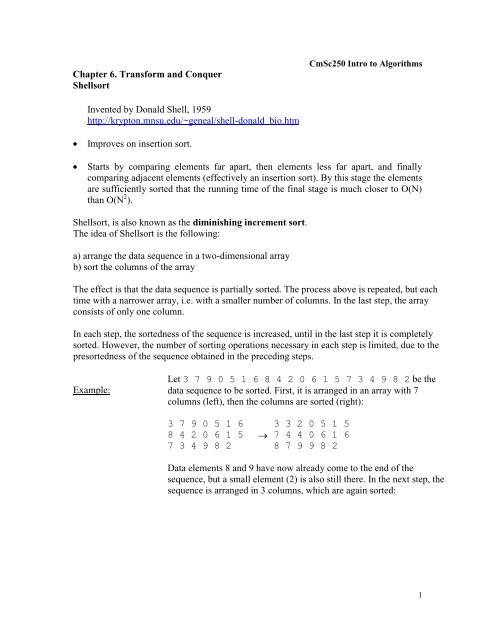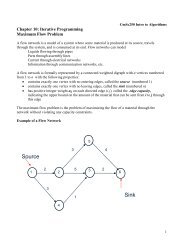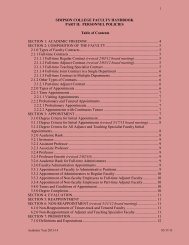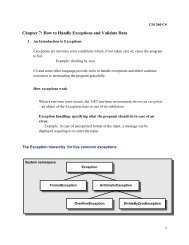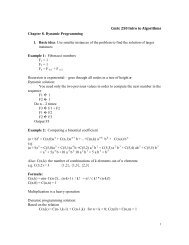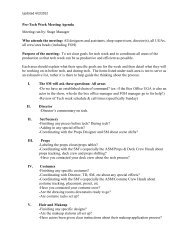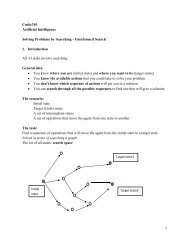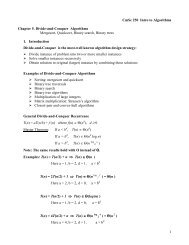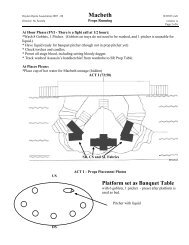Create successful ePaper yourself
Turn your PDF publications into a flip-book with our unique Google optimized e-Paper software.
Chapter 6. Transform and Conquer<strong>Shellsort</strong>CmSc250 Intro to AlgorithmsInvented by Donald Shell, 1959http://krypton.mnsu.edu/~geneal/shell-donald_bio.htmImproves on insertion sort.Starts by comparing elements far apart, then elements less far apart, and finallycomparing adjacent elements (effectively an insertion sort). By this stage the elementsare sufficiently sorted that the running time of the final stage is much closer to O(N)than O(N 2 ).<strong>Shellsort</strong>, is also known as the diminishing increment sort.The idea of <strong>Shellsort</strong> is the following:a) arrange the data sequence in a two-dimensional arrayb) sort the columns of the arrayThe effect is that the data sequence is partially sorted. The process above is repeated, but eachtime with a narrower array, i.e. with a smaller number of columns. In the last step, the arrayconsists of only one column.In each step, the sortedness of the sequence is increased, until in the last step it is completelysorted. However, the number of sorting operations necessary in each step is limited, due to thepresortedness of the sequence obtained in the preceding steps.Example:Let 3 7 9 0 5 1 6 8 4 2 0 6 1 5 7 3 4 9 8 2 be thedata sequence to be sorted. First, it is arranged in an array with 7columns (left), then the columns are sorted (right):3 7 9 0 5 1 68 4 2 0 6 1 57 3 4 9 8 23 3 2 0 5 1 57 4 4 0 6 1 68 7 9 9 8 2Data elements 8 and 9 have now already come to the end of thesequence, but a small element (2) is also still there. In the next step, thesequence is arranged in 3 columns, which are again sorted:1
3 3 20 5 15 7 44 0 61 6 87 9 98 20 0 11 2 23 3 44 5 65 6 87 7 98 9Now the sequence is almost completely sorted. When arranging it in onecolumn in the last step, it is only a 6, an 8 and a 9 that have to be moveda little bit to their correct positions.Implementation Actually, the data sequence is not arranged in a two-dimensional array,but held in a one-dimensional array that is indexed appropriately.The <strong>algorithm</strong> uses an increment sequence to determine how far apart elements to besorted are:h 1 , h 2 , ..., h t with h 1 = 1At first elements at distance h t are sorted, then elements at distance h t-1 , etc, until finallythe array is sorted using insertion sort (distance h 1 = 1).An array is said to be h k -sorted if all elements spaced a distance h k apart are sortedrelative to each other.<strong>Shellsort</strong> only works because an array that is h k -sorted remains h k -sorted when h k- 1 -sorted. This means that subsequent sorts with a smaller increment do not undo the workdone by previous phases.The correctness of the <strong>algorithm</strong> follows from the fact that in the last step (with h = 1)an ordinary Insertion Sort is performed on the whole array. But since data are presortedby the preceding steps (h = 3, 7, 21, ...) only few Insertion Sort steps are required.2
int j, p, gap;comparable tmp;for (gap = N/2; gap > 0; gap = gap/2)for ( p = gap; p < N ; p++){tmp = a[p];for (j = p; j >= gap && tmp < a[j- gap]; j = j - gap)a[j] = tmp;}Animations :a[j] = a[j-gap];http://www.sorting-<strong>algorithm</strong>s.com/shell-sorthttp://www.cs.pitt.edu/~kirk/cs1501/animations/Sort2.htmlWhat should the increment sequence be?There are many choices for the increment sequence. Any sequence that begins at 1 andalways increases will do, although some yield better performance than others:1. Shell's original sequence: N/2 , N/4 , ..., 1 (repeatedly divide by 2);2. Hibbard's increments: 1, 3, 7, ..., 2 k - 1 ; k = 1, 2, …3. Knuth's increments: 1, 4, 13, ..., (3 k - 1) / 2 ; k = 1, 2, …4. Sedgwick’s increments: 1, 5, 19, 41, 109, 209, 505, 929, 2161, 3905, ....The sequence is obtained by interleaving the elements of two sequences:1, 19, 109, 505, 2161,….. 9 (4 k – 2 k ) + 1, k = 0, 1, 2, 3,…5, 41, 209, 929, 3905,…..2 k+2 (2 k+2 – 3 ) + 1, k = 0, 1, 2, 3, …AnalysisA <strong>Shellsort</strong>'s worst-case performance using Hibbard's increments is Θ(n 3/2 ).The average performance is thought to be about O(n 5/4 )The exact complexity of this <strong>algorithm</strong> is still being debated .Experience shows that for mid-sized data (tens of thousands elements) the <strong>algorithm</strong>performs nearly as well if not better than the faster (n log n) sorts.3


